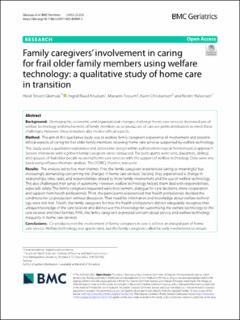| dc.contributor.author | Knutsen, Ingrid Ruud | |
| dc.contributor.author | Fossum, Mariann | |
| dc.contributor.author | Christiansen, Karin | |
| dc.contributor.author | Halvorsen, Kristin | |
| dc.coverage.spatial | south-eastern Norway | en_US |
| dc.date.accessioned | 2022-04-22T11:56:30Z | |
| dc.date.available | 2022-04-22T11:56:30Z | |
| dc.date.created | 2022-04-20T07:33:39Z | |
| dc.date.issued | 2022-03-18 | |
| dc.identifier.issn | 1471-2318 | |
| dc.identifier.uri | https://hdl.handle.net/11250/2992294 | |
| dc.description.abstract | Background: Demographic, economic and organisational changes challenge home care services. Increased use of welfare technology and involvement of family members as co-producers of care are political initiatives to meet these challenges. However, these initiatives also involve ethical aspects.
Method: The aim of this qualitative study was to explore family caregivers’ experience of involvement and possible ethical aspects of caring for frail older family members receiving home care services supported by welfare technology.
This study used a qualitative explorative and descriptive design within a phenomenological-hermeneutical approach. Sixteen interviews with eighteen family caregivers were conducted. The participants were sons, daughters, siblings and spouses of frail older people receiving home care services with the support of welfare technology. Data were analysed using reflexive thematic analysis. The COREQ checklist was used.
Results: The analysis led to five main themes. First, the family caregivers’ experienced caring as meaningful but increasingly demanding concerning the changes in home care services. Second, they experienced a change in relationships, roles, tasks, and responsibilities related to more family involvement and the use of welfare technology. This also challenged their sense of autonomy. However, welfare technology helped them deal with responsibilities, especially safety. The family caregivers requested early involvement, dialogue for care decisions, more cooperation and support from health professionals. Third, the participants experienced that health professionals decided the conditions for co-production without discussion. Their need for information and knowledge about welfare technology were not met. Fourth, the family caregivers felt that the health professionals did not adequately recognise their unique knowledge of the care receiver and did not use this knowledge for customising the welfare technology to the care receiver and their families. Fifth, the family caregivers expressed concern about service and welfare technology inequality in home care services.
Conclusions: Co-production in the involvement of family caregivers in care is still not an integral part of home care service. Welfare technology was appreciated, but the family caregivers called for early involvement to ensure successful and safe implementation and use. More attention needs to be given to ethical concerns about the change in relations, transfer of tasks and responsibility, and risk of inequality. | en_US |
| dc.description.sponsorship | This project has been made possible by the Dam Foundation through the Norwegian Health Association. | en_US |
| dc.language.iso | eng | en_US |
| dc.publisher | BMC | en_US |
| dc.relation.ispartofseries | BMC Geriatrics;22, Article number: 223 (2022) | |
| dc.rights | Navngivelse 4.0 Internasjonal | * |
| dc.rights.uri | http://creativecommons.org/licenses/by/4.0/deed.no | * |
| dc.subject | Caregivers | en_US |
| dc.subject | The elderly | en_US |
| dc.subject | Home care | en_US |
| dc.subject | Assistive technology | en_US |
| dc.subject | Welfare technology | en_US |
| dc.title | Family caregivers’ involvement in caring for frail older family members using welfare technology: a qualitative study of home care in transition | en_US |
| dc.title.alternative | Family caregivers’ involvement in caring for frail older family members using welfare technology: a qualitative study of home care in transition | en_US |
| dc.type | Peer reviewed | en_US |
| dc.type | Journal article | en_US |
| dc.description.version | publishedVersion | en_US |
| dc.rights.holder | © The Author(s) 2022 | en_US |
| dc.source.articlenumber | 223 | en_US |
| cristin.ispublished | true | |
| cristin.fulltext | original | |
| cristin.qualitycode | 1 | |
| dc.identifier.doi | https://doi.org/10.1186/s12877-022-02890-2 | |
| dc.identifier.cristin | 2017725 | |
| dc.source.journal | BMC Geriatrics | en_US |
| dc.source.volume | 22 | en_US |
| dc.source.pagenumber | 1-14 | en_US |

